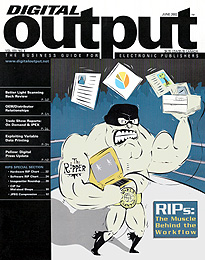|
  June 2002—The RIP, or raster image processor, might be the most under–appreciated, though most necessary, tool in the industry. Nothing goes to press without detouring through a RIP at least once and finding the right one to drive your workflow requires consideration of many variables. We hope to make that journey faster and more efficient with this handy roadmap to RIPs. June 2002—The RIP, or raster image processor, might be the most under–appreciated, though most necessary, tool in the industry. Nothing goes to press without detouring through a RIP at least once and finding the right one to drive your workflow requires consideration of many variables. We hope to make that journey faster and more efficient with this handy roadmap to RIPs.
All RIPs do essentially the same thing – they take your PDF or Illustrator or Quark or Photoshop or Corel file and translate it into a language that the press or printer can read – Adobe Postscript Level 3. The ability to handle PDF files, a trend that had gained considerable ground in the last year or two, is now a universal ability.
Transparency, which was a popular web design feature that gave prepress operators nightmares in the past, is now handled adroitly by most RIPs, with the rest promising compatibility in the coming year. Remote functionality, the ability to access the RIP from a computer workstation, has gained almost universal acceptance, with just a few products not offering it.
But even with all these similarities, each product has its own quirks and fits into workflows a little bit differently. Different RAM requirements, processor speeds and hard drive space contribute to the speed at which a file can be RIPped. The number of jobs that can be RIPped simultaneously varies considerably, with most hardware RIPs supporting only one at a time and most software supporting 10 or more at a time. The cost also varies widely, from around $500 all the way up to $55,000.
There are far more software RIPs out there than hardware. These are usually cheaper than their hardware counterparts, and can feature about the same amount of functionality. Software versions also claim to support a wider variety of printers than hardware. On the other hand, using a software RIP means either dedicating a workstation to RIPing or slowing down the speed of your active workstations. Volume is a big factor to consider in deciding between the two. Another factor to consider is that while most hardware RIPs support trapping, many software RIPs do not.
In the course of the next year there will be a few things to watch for in the world of RIPs. Dot proofing, which is not widely integrated right now, will probably gain more ground as the proofing press technology improves. Right now, few proofer/printers simulate the halftone dots produced on a four-color web press. As that feature gains ground, RIP technology will have to catch up.
It will also be interesting to see how new file formats like JDF and JPEG2000 will fit in. As new standards become popular, RIP manufacturers will have to add the ability to handle them. Whether that will come in the form of patches and updates or new products altogether remains to be seen. (For a closer look at JPEG compression, see our article on page 32)
Handling JDF (job definition format) files, which was predicted to be huge in the RIP world last year, has not gained much ground. This doesn’t mean that CIP4, the organization that developed the standard, has given up. They gave several seminars at IPEX this year and continue to push JDF as the standard of the future. They have some big names on board – Adobe, Creo, Agfa, EFI, Global Graphics and Best GmbH to name a few – which means that while the format has not gained widespread acceptance it remains something to keep a close eye on in the coming year.
As you browse the data on the following pages you will probably note the omission of some big RIP names, Global Graphics’ popular Jaws and Harlequin RIPs among them. Harlequin and Jaws are sold directly to OEMs who tweak the specs of the RIP to their respective machines and workflow solutions. Often these OEMs re-brand the RIP under their own name. All of which makes it difficult to include them in a chart such as this one without oversimplifying their sophisticated adaptability.
Also, keep in mind that many of the commercial manufacturers specified that their products are customizable to the size and needs of their customers, which will impact the functionality and price of the final unit.
This chart details the specifics of many of the RIPS that are out there, though we can’t guarantee the list is comprehensive. Use it to help you narrow your focus when shopping for the RIP that will work best for your shop.
A RIP can mean the difference between getting the job on the press in an hour or five hours. A good RIP can mean the difference between having an image come out exactly how you want it to, or having to tweak the file a few times to get the desired look. Is it the only component to producing great work? Well no, but it is an integral part of the process that should not be overlooked.
|


